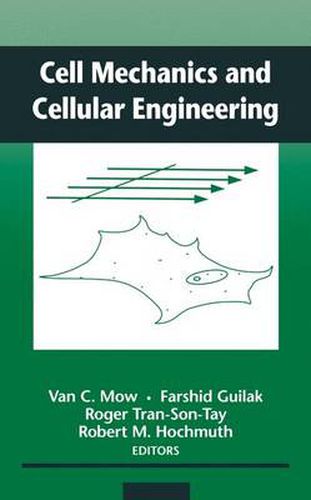Readings Newsletter
Become a Readings Member to make your shopping experience even easier.
Sign in or sign up for free!
You’re not far away from qualifying for FREE standard shipping within Australia
You’ve qualified for FREE standard shipping within Australia
The cart is loading…






This title is printed to order. This book may have been self-published. If so, we cannot guarantee the quality of the content. In the main most books will have gone through the editing process however some may not. We therefore suggest that you be aware of this before ordering this book. If in doubt check either the author or publisher’s details as we are unable to accept any returns unless they are faulty. Please contact us if you have any questions.
Cell mechanics and cellular engineering may be defined as the application of principles and methods of engineering and life sciences toward fundamental understanding of structure-function relationships in normal and pathological cells and the development of biological substitutes to restore cellular functions. This definition is derived from one developed for tissue engineering at a 1988 NSF workshop. The reader of this volume will see the definition being applied and stretched to study cell and tissue structure-function relationships. The best way to define a field is really to let the investigators describe their areas of study. Perhaps cell mechanics could be compartmentalized by remembering how some of the earliest thinkers wrote about the effects of mechanics on growth. As early as 1638, Galileo hypothesized that gravity and of living mechanical forces place limits on the growth and architecture organisms. It seems only fitting that Robert Hooke, who gave us Hooke’s law of elasticity, also gave us the word cell in his 1665 text, Micrographid, to designate these elementary entities of life. Julius Wolffs 1899 treatise on the function and form of the trabecular architecture provided an incisive example of the relationship between the structure of the body and the mechanical load it bears. In 1917, D’ Arcy Thompson’s On Growth and Form revolutionized the analysis of biological processes by introducing cogent physical explanations of the relationships between the structure and function of cells and organisms.
$9.00 standard shipping within Australia
FREE standard shipping within Australia for orders over $100.00
Express & International shipping calculated at checkout
This title is printed to order. This book may have been self-published. If so, we cannot guarantee the quality of the content. In the main most books will have gone through the editing process however some may not. We therefore suggest that you be aware of this before ordering this book. If in doubt check either the author or publisher’s details as we are unable to accept any returns unless they are faulty. Please contact us if you have any questions.
Cell mechanics and cellular engineering may be defined as the application of principles and methods of engineering and life sciences toward fundamental understanding of structure-function relationships in normal and pathological cells and the development of biological substitutes to restore cellular functions. This definition is derived from one developed for tissue engineering at a 1988 NSF workshop. The reader of this volume will see the definition being applied and stretched to study cell and tissue structure-function relationships. The best way to define a field is really to let the investigators describe their areas of study. Perhaps cell mechanics could be compartmentalized by remembering how some of the earliest thinkers wrote about the effects of mechanics on growth. As early as 1638, Galileo hypothesized that gravity and of living mechanical forces place limits on the growth and architecture organisms. It seems only fitting that Robert Hooke, who gave us Hooke’s law of elasticity, also gave us the word cell in his 1665 text, Micrographid, to designate these elementary entities of life. Julius Wolffs 1899 treatise on the function and form of the trabecular architecture provided an incisive example of the relationship between the structure of the body and the mechanical load it bears. In 1917, D’ Arcy Thompson’s On Growth and Form revolutionized the analysis of biological processes by introducing cogent physical explanations of the relationships between the structure and function of cells and organisms.